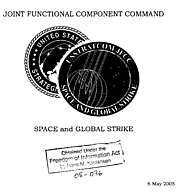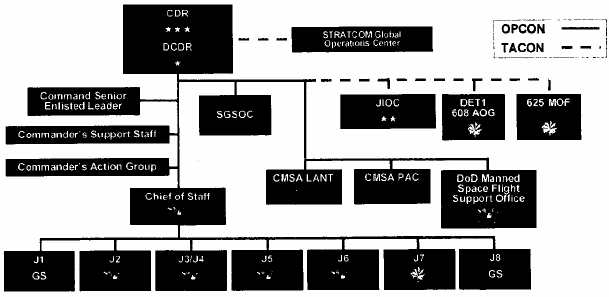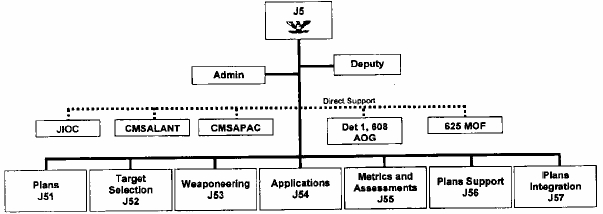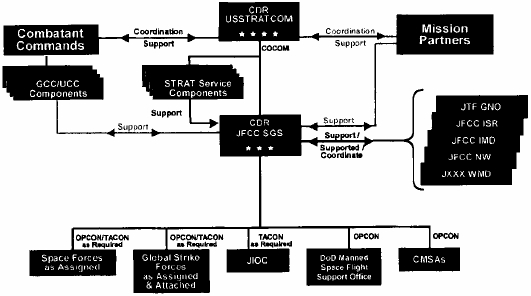 |
|
The Concept of Operations for the newly
established Space and Global Strike component command has
recently been
declassified. |
Nuclear Brief March 15, 2006 (updated August 8, 2006)
Space and Global Strike Concept of Operations
(Update August 8, 2006: Space and
Global Strike has been reorganized and is now called Global Strike
Integration. Space is a separate Component Command)
The Concept of Operations (CONOPS)
for Joint Functional Command Command Space and Global Strike (JFCC SGS)
was published on May 6, 2005. The document, which was recently
declassified and released under FOIA, outlines the operational capabilities and requirements for JFCC SGS
as well as the organization of the
newly established component command. The
document states that "JFCC SGS leads integration of USSTRATCOM
operational capabilities" and supports day-to-day activities within
USSTRATCOM. Finally, the CONOPS describes the expertise required for
preparation of companion CONOPS, standard operating procedures, space
and global strike annexes, implementation plans, and tactics, techniques
and procedures.
The JFCC SGS Commander’s Intent document, which is
embedded in the CONOPS, describes that the purpose of JFCC SGS is to:
a) Gain and maintain both global and theater space superiority and
deliver tailored, integrated, full-spectrum space support to the theater
commander, while maintaining a robust defensive global counter-space
posture.
b) Lead day-to-day planning and integration efforts, and deliver
joint global strike effects through deliberate, adaptive, and crisis
planning, force integration, and robust command and control (C2) to
support global deterrence, theater and national objectives.
Although Global Strike is normally
portrayed almost exclusively as a conventional mission, nuclear weapons
are surprisingly prominent in the CONOPS. JFCC SGS tasks include providing
"operational and
tactical execution capability on short notice with the ability to
operate 24/7 as defined in the Global Strike Interim Capability
Operations Order and fulfill relevant execution responsibility under
USSTRATCOM
OPLAN 8044"
(formerly the SIOP). Specific tasks include:
a) Support the coordination of operational logistical requirements
of USSTRATCOM supported plans, to include
operational logistic support to nuclear
forces.
b) Integrate capabilities, via the Global Operations Center, to
support HQ USSTRATCOM responsibilities for
nuclear force command and control and
nuclear force execution.
c) Support USSTRATCOM-led efforts to create and maintain
strategic-level OPLANs. Support development and coordination of OPLANs,
CONPLANs, FUNCPLANs, and SUPPLANs as directed by HQ USSTRATCOM. Support
other combatant commands with space and global strike operational
planning and execution, as directed by HQ USSTRATCOM.
d) Assume OPCON (Operational Control) and TACON (Tactical Control)
of global strike forces (kinetic and non-kinetic), as directed. This
includes monitoring the
status and
readiness of nuclear forces through existing Service task forces
via the Global Operations Center.
e) Maintain coordination with geographic and functional combatant
commanders to support ongoing and future operational requirements for
USSTRATCOM Space and Global Strike capabilities.
The focus of JFCC SGS will be to provide
operational to tactical level planning, produce fully integrated,
approved COAs and plans, facilitate full spectrum operational
integration, provide command and control for space and global strike
missions and when directed, other USSTRATCOM assigned missions. For
operational and execution matters, and for adaptive planning and time
sensitive planning, the JFCC SGS will serve as "the lead integrating JFCC
for HQ USSTRATCOM." The JFCC SGS Command Structure is shown in Figure
1:
|
Figure 1:
Command Structure For
Joint Functional Component Command Space and Global Strike |
 |
The J3/J4 Operations and Logistics Directorate
maintains continuous global situation awareness, through the Global
Operations Center (GOC), of space and global events and "day-to-day
management of nuclear forces." JFCC SGS J3/J4 also supports the
coordination of operational logistic support to nuclear forces, provides
Consequence of Execution (COE) analysis
support to "pre-OPLAN 8044 activities," and provides
Consequence Management (CM) for
"trans-
and post-OPLAN 8044 activities."
The J5 Plans and Integration Directorate
delivers the 8044 Revision
(formerly the SIOP) Plan. The Directorate consists of seven
sub-divisions: Plans, Target Selection, Weaponeering, Applications,
Metrics & Assessments, Plans Support, and Plans Integration. Among
these, the Target Selection Division (J52) develops operational and
tactical targeting solutions for the
OPLAN 8044 Revision (formerly SIOP) process. The Applications
Division (J54) conducts “level 4 OPLAN
8044 Revision process and GS [Global Strike] planning and integration,
producing and maintaining the 8044 Revision and GS targeting.”
The Metrics and Assessments Division (J55) provides tactics and threat
review for level 3 and 4 planning supporting kinetic and non-kinetic
effects and
analyses OPLAN 8044.
The Plans Support Division (J56) provides systems management of the
Integrated Strategic Planning Analysis Network (ISPAN, formerly SWPS,
Strategic War Planning System), the single planning network used to
design OPLAN 8044 and CONPLAN 8022, and also produces and
maintains the ISPAN Enterprise Data
Base (EDB) which contains the targets for OPLAN 8044 and CONPLAN
8022. For J5 organization, see Figure 2:
|
Figure 2:
Organizational Structure of
Joint Functional Component Command Space and Global Strike
J5 |
 |
The central role and considerable
scope of JFCC SGS in all nuclear strike planning – not just that
supporting Global Strike and CONPLAN 8022 – is evident from the list of
deliverables produced by J5. This includes:
a) The OPLAN 8044 Revision Plan
and required updates in coordination with the Joint Staff, OSD, and HQ
USSTRATCOM.
b) Data updates to the Chairman of the Joint Chiefs of Staff
Nuclear Decision Handbook for the
President, in coordination with HQ USSTRATCOM J38.
c) Global Strike target materials including Global Strike Support
Documents (GSSDs), GS targeting databases, and target folders
across the full spectrum of options
based on politico-military environment. Develops intelligence indicators
in coordination with JFCC SGS J2 and JFCC SGS J3/J4 to be monitored by
the GOC to enhance crisis action responsibilities.
d) The National Target Base, the
repository for all global strike targets.
e) Recommended target lists for
OPLAN 8044, to HQ USSTRATCOM Joint Targeting Coordination Board
for approval as directed.
f) JFCC SGS integrated
input to
USSTRATCOM’s Strategic Support Plan.
g) Integrated planning annexes and materials, as required.
Despite the considerable nuclear tasks assigned to
JFCC SGS, CDRUSSTRATCOM retains overall planning and force execution
responsibility for the nuclear mission at STRATCOM Headquarters.
JFCC SGS is supported by several
external units that directly support the mission. This includes the Navy’s Cruise Missile Support Agencies (CMSAs) in Virginia
and Hawaii for Tomahawk land-attack mission planning, the Air Force’s
625 MOF (Missile Operations Flight) at Offutt AFB for
ICBM target analysis, and
Detachment 1 of the Air Force’s 608 AOG (Air Operations Group) at Offutt
AFB. Other direct supporting units include the Joint Space Operations
Center at Vandenberg Air Force Base, California for direct day-to-day
planning and execution of assigned military space forces. Also, the Air
Operations Center at Barksdale Air Force Base in Louisiana supports JFCC
SGS with critical planning expertise to develop fully integrated global
strike course-of-actions (COAs) across the spectrum of joint operations
for both deliberate and time sensitive planning tasks and assist in
executing missions as directed. Finally, J5 also coordinates directly
with the operational units and United Kingdom Ministry of Defence. For external relationships for JFCC SGS,
see Figure 3:
|
Figure 3:
External Relationships For
Joint Functional Component Command Space and Global Strike |
 |
|

